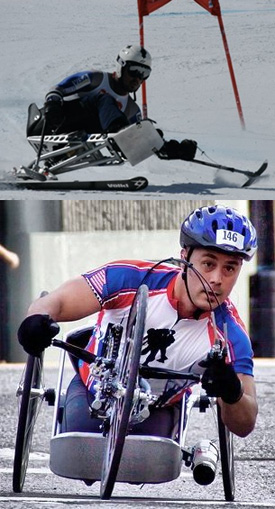 |
| A picture of a veteran posing for the camera. |
To learn more about CrossFit, go to: http://www.crossfit.com/cf-info/what-crossfit.html.
 |
| A man with a lower limb disability is skiing down a slope while another man that uses a wheelchair is cycling. |
Michael Paul training for CrossFit Certification at Camp Pendleton
http://www.youtube.com/watch?v=79wxkLmF9e0
It is not often that you see fitness trends address varying levels of abilities, and it is even less common to see fitness professionals with disabilities being incorporated into the culture of the program. One note of caution: CrossFit is not for everyone. If you search the term, one of the popular articles that appears is "How Not to Get Hurt Doing CrossFit." It could be considered by some as an elite athlete workout that is a bit on the extreme side. I am certainly not suggesting that anyone reading this article with or without a disability should immediately go out and try CrossFit. Instead, I would simply like to present the program and allow you to decide if it sounds right for you. CrossFit athletes run, row, jump rope, climb rope, and carry odd-shaped objects. They frequently move large loads quickly over short distances, and use powerlifting and Olympic weightlifting techniques. CrossFit athletes also use various fitness modalities and methods, such as dumbbells, gymnastics rings, pull-up bars, kettlebells, and many bodyweight exercises. As you will see from Michael Paul's experience, it can work for an individual with a disability quite well. "It's amazing what CrossFit has done for my core strength," Michael says.
From Michael Paul's bio, you quickly learn that he was born an athlete into a proud military family that has a strong belief in honor and serving. He used his athletic abilities in the Army to secure a job working in an elite unit attached to the military intelligence as a recon soldier. He served during the Gulf War, and specialized in airborne, air assault, and special ops warfare. He went to Ranger school, SERE school, Close Quarter Combat School, and various other training schools that put his athletic prowess to the test.
After the military, Michael decided to go to college using the GI Bill while working as a personal trainer, kickboxing instructor, and later, a massage therapist. Although out of the military, he still had the desire for adventure, seeking activities in recreation and sport. However, on September 29, 2002, Michael had a skydiving accident, which resulted in a lower level (L1) spinal cord injury. He could have decided to hang up his athletic passions, but instead he decided to take up competitive wheelchair tennis within the same year of his accident. According to Michael, his life was definitely not over. He made a firm resolution to use his abilities to the same extent that he did prior to his injury.
Michael's love and passion for sports never diminished. Shortly after his accident, he took up competitive wheelchair tennis, in which he trained for 3 years and ranked third in the U.S. for Men's A division. In the last few years, Michael has added mono-skiing to his list, and became a member of the Aspen Competition Ski Team in Aspen, Colorado. Also, he became a ski racer for Challenge Aspen, which was sponsored by Challenged Athletes Foundation Operation Rebound. And just last year, Michael participated in his first LA Marathon, and finished in third place in his division. Currently, he is training again for the LA Marathon.
According to Michael, a CrossFit Trainer should be cautious when adapting the program for a person with a disability. But as all good trainers know, any program should be tailored to the individual and his or her needs. Michael's workout includes adaptive rowing on the Concept II, Kranking on the Krankcycle, shoulder presses, and kettlebell workouts in addition to training for marathons. He believes that his focus on his core strength has helped him in competitive skiing and in everyday functional activities.
 |
| Two veterans that use wheelchairs are talking to a third man wearing an army uniform. |
Through his participation in various competitions and races, Michael is very thankful for his past and current sponsors. He would like to mention and highlight the CAF Operation Rebound for ski race sponsorship ski race, the Mission Continues for CrossFit certification, ski instructor certification, and fellowship with the Paralyzed Veterans of America. And lastly, Project Visibility for the training in Krankcycle and Wounded Warriors for supporting his attendance to adaptive sports clinics.
As you can see, Michael is an athlete and loves fitness, adventure, and competition. Besides the physical benefits of living an active lifestyle, he believes that participating in adaptive sports builds confidence, self-esteem, and independence. If this sounds like you, CrossFit might be your next adventure!
For comments and feedback, please feel free to contact Amy Rauworth at amyr@lakeshore.org
